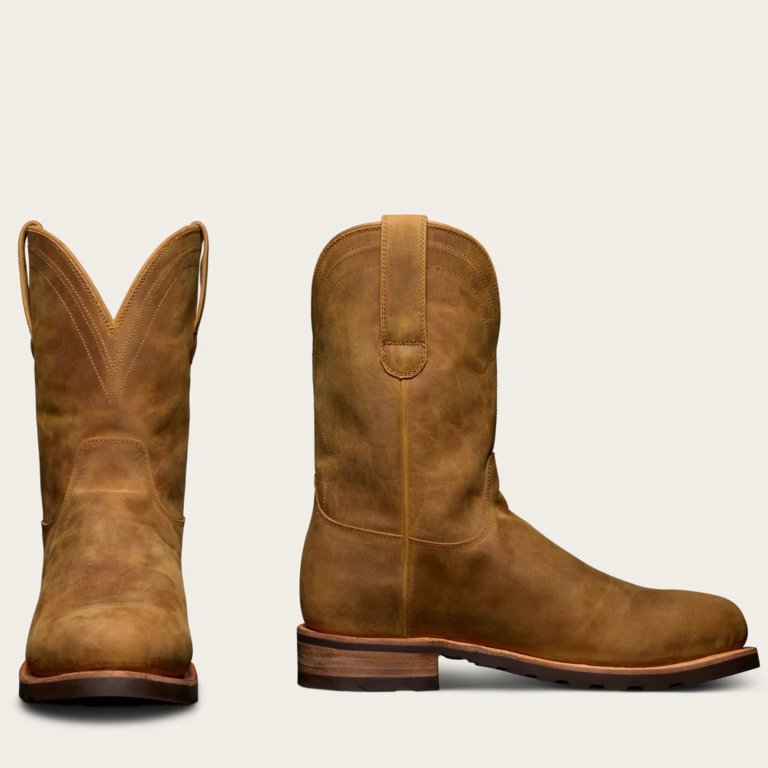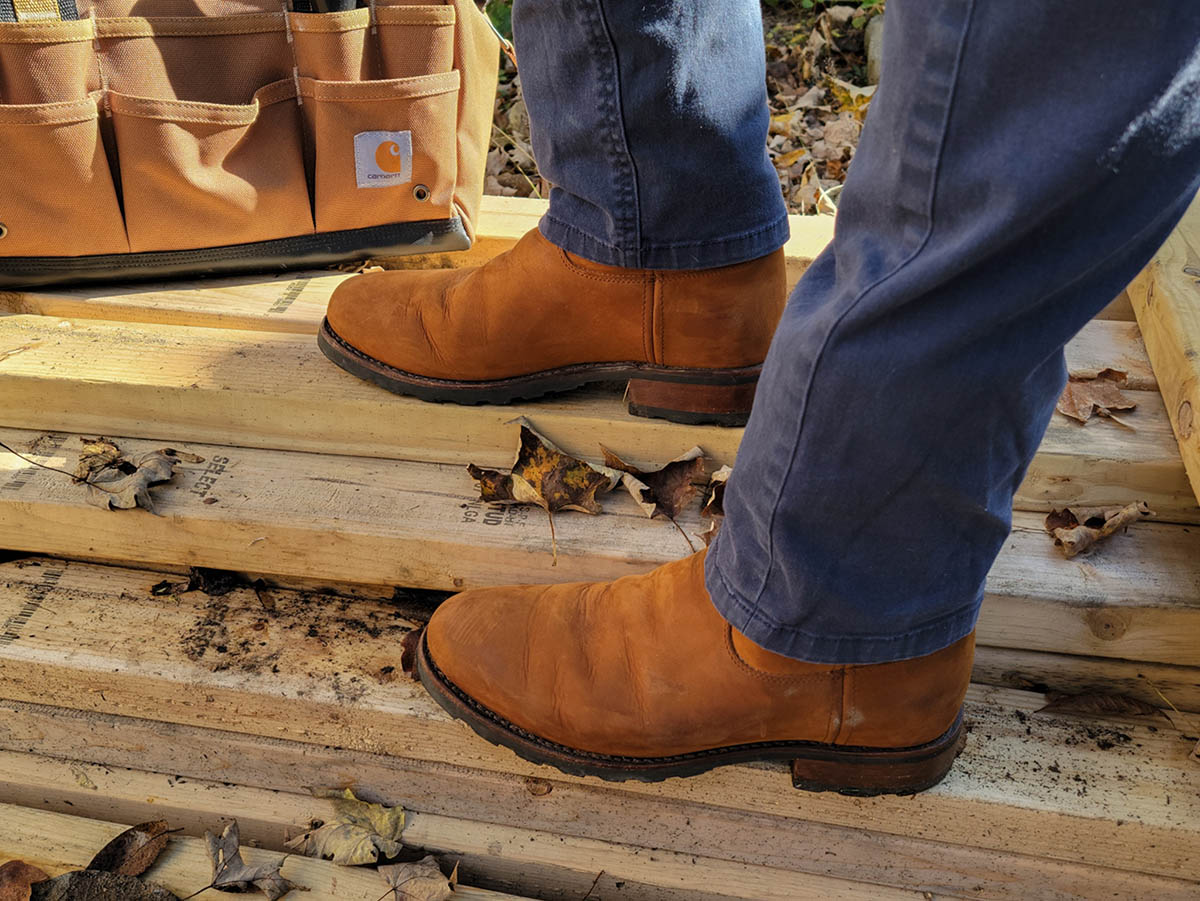

We may earn revenue from the products available on this page and participate in affiliate programs. Learn More ›
I’ve worn a lot of work boots in my time, and I’ve considered myself a loyalist of a brand or two. I generally prefer a standard moc-toe work boot with a wedge sole, even before they became trendy. When Tecovas offered the opportunity to try out the brand’s new work boot line, I wasn’t sure what to expect. As far as I knew, Tecovas made western boots—and, being from the Northeast, I never considered owning a pair, let alone wearing them on a construction site or during a renovation. But Tecovas Stocktons proved to be quite different from a traditional western or cowboy boot.
So what did this Yankee think of a pair of boots more likely to be found building fences on a Texas ranch than nailing cedar shakes on a cottage in upstate New York? Read on for my Tecovas Stocktons review.
At a Glance
Tecovas Stockton Work Boot
Pros
- Vibram sole like a traditional work boot provides traction and durability
- Resoleable Goodyear welt
- Treated leather and weatherproof seams add durability and comfort when working in the elements
Cons
- These boots are a bit different than traditional work boots so they do take some time getting used to
- Cannot be tightened in the way traditional work boots with laces can
Rating: 4/5
Get the Tecovas Stockton Work Boots at Tecovas.com starting at $285
What Is the Tecovas Stockton Work Boot?
The Stockton is a new work boot from western boot manufacturer Tecovas. The company is based in Texas, and their wares are made by traditional boot-makers in Leon, Mexico.
The Stockton is a full-grain leather boot, meaning Tecovas uses the entire thickness of the hide for the most durability and quality possible. It features a Vibram oil- and slip-resistant sole, very similar to a quality standard work boot. The leather and seams are treated to be weatherproof, and there are shock-absorbing polyurethane insoles with leather lining for comfort. Also, the sole is replaceable, thanks to the Goodyear welt construction.
While this may seem pretty basic and familiar, it’s only half the story—so get ready for the plot twists! The Stockton features a 1½-inch stacked leather heel, which is very different from most traditional work boots. The heel features thick layers of leather with a rubber Vibram cap on the bottom. Also, as western boots, they are pulled on rather than laced up. The 10-inch shaft (the area around the lower leg) is unlined, with the rough side of the grain on display inside. The shaft is fairly unstructured, allowing for comfortable contact with the leg. All of these attributes describe what’s known as “roper-style” in the world of western boots.
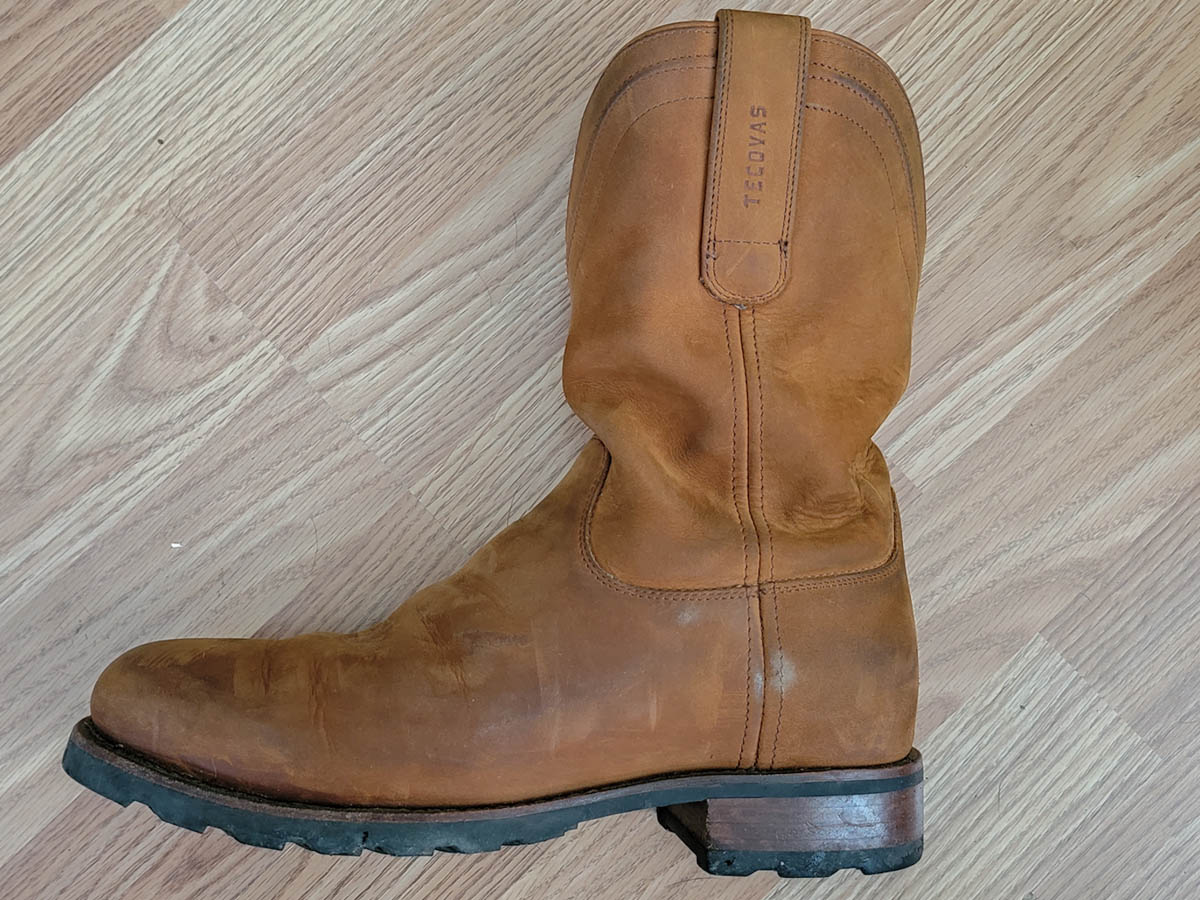
Testing the Tecovas Stockton Work Boots
I wore my Stocktons on a few projects, including a long day of welding, a home-addition project, and plenty of trips to the lumber yard and home center. Based on these long hours, I felt I was really able to offer an honest assessment of their performance.
Putting the Boots On
Stocktons are not as easy to put on as traditional work boots, but they’re not impossible, either. Tecovas sent a card in the box that suggested putting the boot on the ground and sliding my foot into it, rather than lifting the boot in the air and pulling it on the foot. I didn’t find this to be necessary, as the mostly unstructured shaft was flexible enough to sneak my foot into. However, if you plan to put these boots by the door and slip them on quickly without using your hands, think again, partner; it won’t work. That said, if your finger joints are a little too stiff to tie a pair of boots in the morning, Stocktons may be a good option for you.
Once I got the Stocktons on, I found that they don’t fit like rain boots or Wellingtons, since they’re designed to hug the foot to prevent it from slipping out. Initially, I found them a little tight in the toe box, but they loosened up after a few projects. Tecovas says it’s normal for the heel to lift slightly while walking, so if you aren’t a western boot connoisseur, don’t fret over a bit of heel lift.
Overall Comfort
Let’s get down to the most important aspect of any work boot: comfort both during and after a project. I had my Stocktons for about 9 months before writing this review, so I feel capable of judging their comfort level in different seasons. While I found them wonderful to wear in the spring, especially in muddy conditions, they felt far too warm during the summer. Since the weather cooled, I’ve been putting them through their paces again.
I recently built an addition and opted to wear only the Stocktons during the construction. They were very comfortable to work in during all stages of the project, from framing to flooring. Even underneath me while I was curled up and lying on the floor, the Stocktons felt very good on my feet. Other than being a little looser than I’m used to when kicking a framed wall into perfect alignment, they were just like wearing a traditional pair of work boots.
Here’s the best part about the Stocktons: After a long day on my feet, kicking them off was a breeze. This is important to me, since I get a little sorer than I used to, partly due to getting older and also due to the fact that I don’t do as much construction as I used to. So I was pleased that the Stocktons slipped right off and my feet felt great after wearing them all day.
The only real complaint I have, comfort-wise, is that walking in western boots is slightly different than walking in a pair of traditional work boots. There’s a more pronounced rock between the heel hitting the floor and the ball of the foot landing. At first, it felt a bit mechanical, but I got used to it after a day or two.
And maybe this is a picky point, but the boots do make me about an inch taller, which means picking fallen nails and boards up off the floor requires a deeper bend.
Grip
First, I love Vibram soles, and the ones Tecovas puts on the Stockton boots are great. No matter the weather or conditions, these soles were grippy and sure-footed. I’m not sure if they saw any oil, but I don’t remember slipping a single time while wearing them.
The only thing I found to be strange came when kicking an object into place. Since there aren’t any laces, I wasn’t able to tighten the Stocktons around my ankles. While my feet are wide, my ankles aren’t, so kicking anything into place wedged the widest part of my foot further into the boot. It wasn’t painful, but it did require some adjustment after the kick to feel comfortable again.
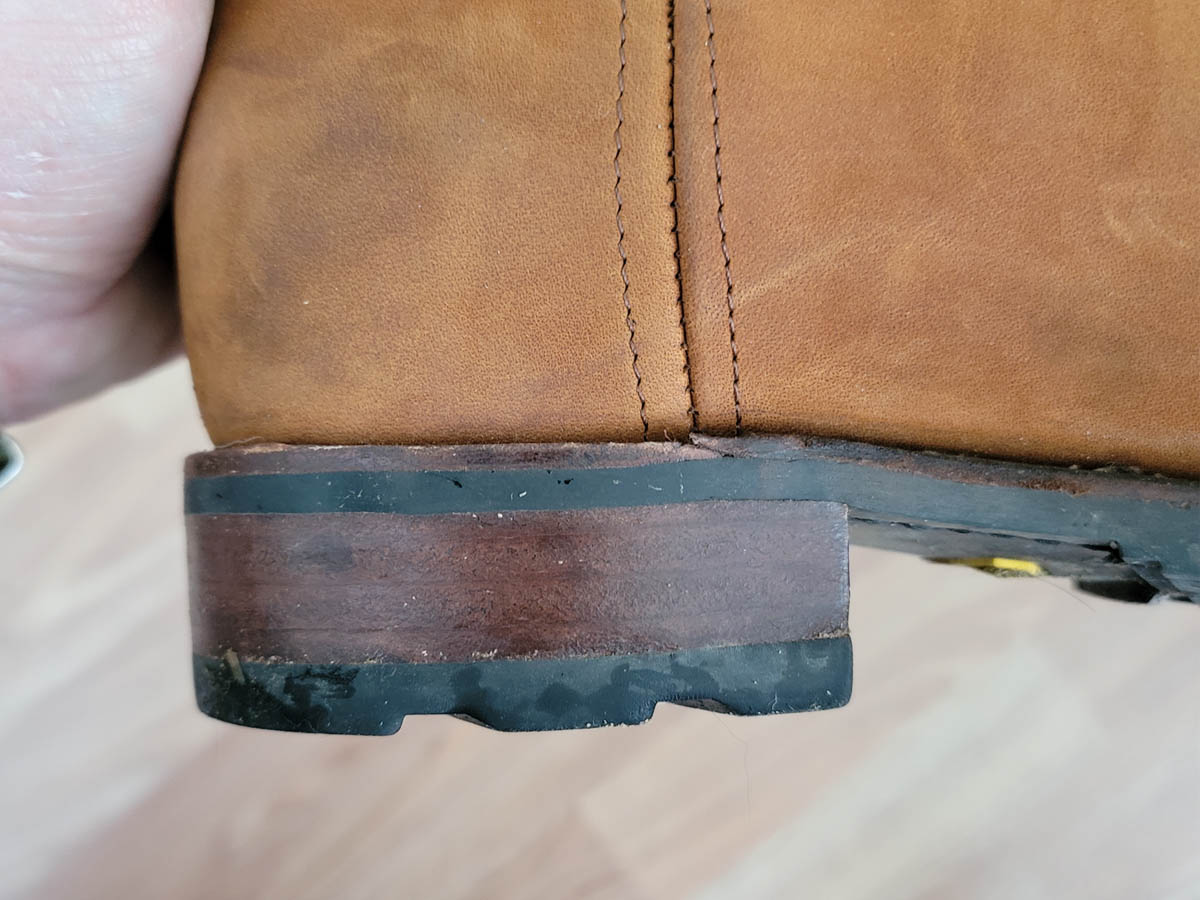
Appearance
Although I was pretty impressed with the fit and comfort of these Stocktons, I had to wonder: Would these boots be so western inspired that I’d rarely wear them? I’m happy to say that it doesn’t matter if you’re feeding livestock on a ranch in Texas, replacing 200-year-old window panes in a New England Cape Cod, or building timber-framed homes from Douglas fir in the Pacific Northwest, the Stocktons will meet the dress code.
At their core, Stockton work boots are western ropers, but they can pass for traditional work boots at a glance. The toe isn’t as tapered as cowboy boots typically are, and there’s no fancy tooling or stitching to draw attention. They’re just a simple, straightforward leather work boot with a western influence, and they look just fine under a pair of jeans or work pants. No one’s going to tease you or call you a rodeo reject. Will I buy other western boots? Probably not. But I’d buy more work boots from Tecovas.
I’ll add, the leather is terrific. Even with all the rough weather they’ve seen, the projects they’ve been on, and the sparks from welding, they still look outstanding. Other than a few creases and a slight nick here and there, they look like they just came out of the box.
Are the Tecovas Stockton Work Boots Worth It?
The Tecovas Stockton work boots retail for around $245 for the bovine and $265 for the bison. Sure, I remember a time when all of my work boots came from a department store shelf and cost between $80 and $100. I’d wear them hard, so it’s no surprise that the low-quality leather would break down a bit and the cheap soles would wear right off the boot. After about 6 months of hard use, they were garbage, and I’d replace them with another pair.
The Stocktons will last much, much longer than a 6-month stint. First, the full-grain leather is top-notch. Full-grain leather, when maintained properly, actually improves over time. It doesn’t break down like synthetic materials and low-quality leather do. It wears in, becomes more comfortable, and looks outstanding.
Also, the Tecovas Stockton work boots are resoleable. That means I can take them to a cobbler and, for $80 to $120, have the existing sole removed and replaced, giving me a perfectly broken-in pair of boots with brand-new soles. In my opinion, that’s pretty hard to beat. And if I no longer like the type of heel originally used, I can choose something different (like my beloved Vibram wedge).
Those are the types of attributes and options you get with a high-quality work boot like the Stockton. And most high-quality work boots are more expensive, making these Tecovas boots a steal for just north of $200.
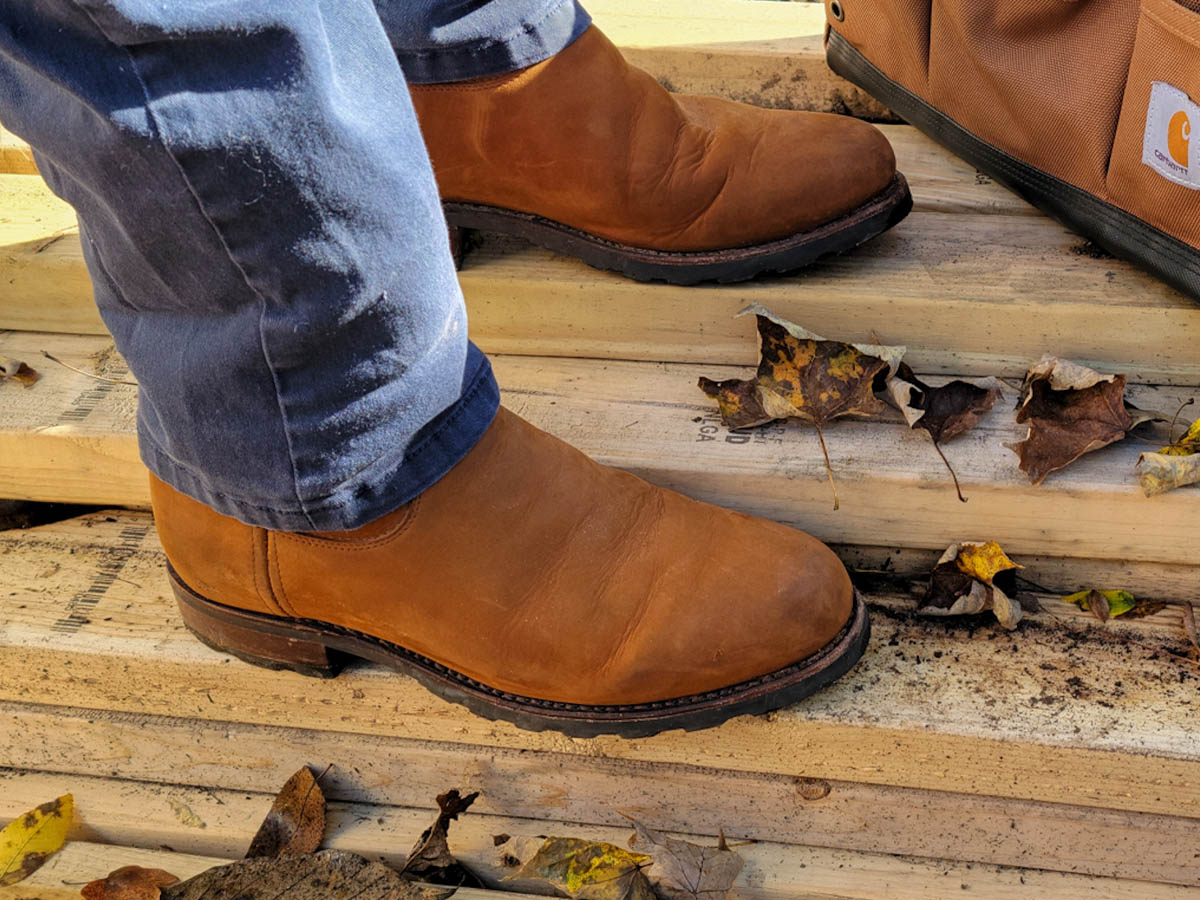
Final Thoughts
First, I do believe that anyone can wear and enjoy these work boots. They’re high quality, they look good, and they are very comfortable. But they might not be the best work boots for everyone.
For example, if your workplace requires a safety toe, the Stocktons don’t come with steel, safety, or composite toes. This is probably because western boots are supposed to fit through a stirrup, and the bulk of a safety toe might make that difficult.
Also, if you need a snug fit to feel secure and grounded in your work boots, take a pass. In my opinion, the foot is snug enough and comfortable, but the shaft is much looser around the ankle and leg. One way to combat this is to wear thicker socks, but that will likely get pretty hot.
For anyone else who doesn’t mind the look of a mildly western-styled work boot, the Stocktons could be a hit. The materials are top-notch, the quality is outstanding, and fit and design are excellent. And since it’s available in clay bovine, umber (black) bovine, cognac bison, and wheat bison, there’s a variety of aesthetic choices, too.
Where to Buy the Tecovas Stockton Work Boots
Get the Tecovas Stockton Work Boots at Tecovas.com starting at $245
Meet the Tester
Tom Scalisi is a full-time DIY and construction writer for many of the largest websites in the industry, including BobVila.com, This Old House, Family Handyman, and Forbes as well as his own pest control blog. He spent years in the trades, from building maintenance to carpentry and contracting, and he’s collected his share of work gear throughout those jobs—boots included.
